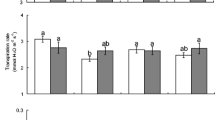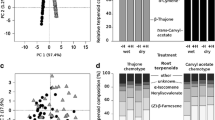Abstract
Tolerance is a type of defense that allows plants to attenuate the negative effects of herbivory. Tolerance has been shown to be context-dependent, contingent on abiotic and biotic factors such as nutrients and plant age. Here, we determine the simultaneous effect of herbivory at different phenological stages and nitrogen regimen on the potato’s ability to tolerate herbivory. We subjected young and blooming plants of two potato varieties to 50% injury by Colorado Potato Beetle in low and high nitrogen environments to determine their effects on tuber yield and plant tolerance. All plants in the high nitrogen treatment expressed higher yield and tolerance compared to those in the low nitrogen treatment. Control plants expressed higher yield than plants in either herbivory treatment. There was a variety by phenological stage of herbivory interaction showing that phenological-based tolerance expression within species is genotype dependent.
Resumen
La tolerancia es un tipo de defensa que le permite a las plantas atenuar los efectos negativos de los herbívoros. Se ha demostrado que la tolerancia es dependiente del contexto, supeditada a factores abióticos y bióticos, como los nutrientes y la edad de la planta. Aquí nosotros determinamos el efecto simultáneo de los herbívoros en diferentes estados fenológicos y el régimen de nitrógeno en la habilidad de la papa para tolerar a los herbívoros. Expusimos plantas jóvenes y en floración de dos variedades de papa al daño en un 50% por el escarabajo de Colorado en ambientes de bajo y alto nitrógeno, para determinar sus efectos en rendimiento de tubérculo y tolerancia de la planta. Todas las plantas del tratamiento con alto nitrógeno expresaron mayor rendimiento y tolerancia en comparación con aquellas del tratamiento con bajo nitrógeno. Las plantas testigo expresaron más alto rendimiento que las incluidas en cualquiera de los tratamientos herbívoros. Hubo interacción entre variedad por etapa fenológica en los herbívoros, mostrando que la expresión de la tolerancia basada en la fenología dentro de las especies es dependiente del genotipo.




Similar content being viewed by others
References
Alward, R.D., and A. Joern. 1993. Plasticity and overcompensation in grass responses to herbivory. Oecologia (Berlin) 95: 358–364.
Alyokhin, A., M. Baker, D. Mota-Sanchez, G. Dively, and E. Grafius. 2008. Colorado potato beetle resistance to insecticides. American Journal of Potato Research 85 (6): 395–413.
Boege, K. 2005. Influence of plant ontogeny on compensation to leaf damage. American Journal of Botany 92 (10): 1632–1640.
Boege, K., and R.J. Marquis. 2005. Facing herbivory as you grow up: The ontogeny of resistance in plants. Trends in Ecology and Evolution 20 (8): 441–448.
Boege, K., R. Dirzo, D. Siemens, and P. Brown. 2007. Ontogenetic switches from plant resistance to tolerance: Minimizing costs with age? Ecology Letters 10 (3): 177–187.
Boodley, J.W., and R. Sheldrake. 1977. Cornell peat-lite mixes for commercial plant growing. Ithaca: Cornell University.
Borowicz, V.A., and A.H. Fitter. 1990. Effects of endomycorrhizal infection, artificial herbivory, and parental cross on growth of Lotus corniculatus L. Oecologia 82 (3): 402–407.
Burghardt, K.T. 2016. Nutrient supply alters goldenrod's induced response to herbivory. Functional Ecology 30 (11): 1769–1778.
Coley, P.D., J.P. Bryant, and F.S. Chapin. 1985. Resource availability and plant antiherbivore defense. Science 230 (4728): 895–899.
Gao, S., W.L. Pan, and R.T. Koenig. 1998. Integrated root system age in relation to plant nutrient uptake activity. Agronmy Journal 90 (4): 505–510.
Gardner, B.R., and J.P. Jones. 1975. Petiole analysis and the nitrogen fertilization of Russet Burbank potatoes. American Potato Journal 52 (7): 195–200.
Garrido, E., A.E. Bennett, J. Fornoni, and S.Y. Strauss. 2010. Variation in arbuscular mycorrhizal fungi colonization modifies the expression of tolerance to above-ground defoliation. Journal of Ecology 98 (1): 43–49.
Gertz, A.K., and C.E. Bach. 1995. Effects of light and nutrients on tomato plant compensation for herbivory by Manduca sexta (Lepidoptera: Sphingidae). Great Lakes Entomologist 27 (4): 217.
Hansson, M.L. 1994. Response of Anthriscus sylvestris (L.) Hoffm. to defoliation and different nitrogen supply levels. Swedish Journal of Agricultural Research (Sweden). http://agris.fao.org/agris-search/search.do?recordID=SE9410708.
Hare, J.D. 1990. Ecology and management of the Colorado potato beetle. Annual Review of Entomology 35 (1): 81–100.
Hartley, S.E., and L. Amos. 1999. Competitive interactions between Nardus stricta L. and Calluna vulgaris (L.) Hull: The effect of fertilizer and defoliation on above-and below-ground performance. Journal of Ecology 87 (2): 330–340.
Hartvigsen, G., D.A. Wait, and J.S. Coleman. 1995. Tri-trophic interactions influenced by resource availability: predator effects on plant performance depend on plant resources. Oikos 743 (3): 463–468.
Hawkes, C.V., and J.J. Sullivan. 2001. The impact of herbivory on plants in different resource conditions: A meta-analysis. Ecology 82 (7): 2045–2058.
Hilbert, D.W., D.M. Swift, J.K. Detling, and M.I. Dyer. 1981. Relative growth rates and the grazing optimization hypothesis. Oecologia 51: 14–18.
Hothorn, T., F. Bretz, and P. Westfall. 2008. Simultaneous inference in general parametric models. Biometrical Journal 50 (3): 346–363.
Houle, G., and G. Simard. 1996. Additive effects of genotype, nutrient availability and type of tissue damage on the compensatory response of Salix planifolia ssp. planifolia to simulated herbivory. Oecologia 107 (3): 373–378.
Karimi, M.M., and K.H.M. Siddique. 1991. Crop growth and relative growth rates of old and modern wheat cultivars. Crop and Pasture Science 42 (1): 13–20.
Maschinski, J., and T.G. Whitham. 1989. The continuum of plant-responses to herbivory: The influence of plant-association, nutrient availability, and timing. American Naturalist 134: 1–19.
Pinheiro, J., D. Bates, S. DebRoy, D. Sarkar, and R Core Team. 2017. nlme: Linear and Nonlinear Mixed Effects Models. R package version 3.1-131.
Poveda, K., M.I.G. Jiménez, and A. Kessler. 2010. The enemy as ally: Herbivore-induced increase in crop yield. Ecological Applications 20 (7): 1787–1793.
R Core Team (2015). R: A language and environment for statistical computing. R Foundation for Statistical Computing, Vienna. URL https://www.R-project.org/.
Rosenthal, J.P., and P.M. Kotanen. 1994. Terrestrial plant tolerance to herbivory. Trends in Ecology & Evolution 9 (4): 145–148.
Sablon, L., J.C. Dickens, É. Haubruge, and F.J. Verheggen. 2013. Chemical ecology of the Colorado potato beetle, Leptinotarsa decemlineata (Say) (Coleoptera: Chrysomelidae), and potential for alternative control methods. Insects 4 (1): 31–54.
Sadras, V.O., L.J. Wilson, and D.A. Lally. 1998. Water deficit enhanced cotton resistance to spider mite herbivory. Annals of Botany 81 (2): 273–286.
Stieha, C., and K. Poveda. 2014. Tolerance responses to herbivory: Implications for future management strategies in potato. Annals of Applied Biology 166 (2): 208–217.
Strauss, S.Y., and A.A. Agrawal. 1999. The ecology and evolution of plant tolerance to herbivory. Trends in Ecology & Evolution 14 (5): 179–185.
Vargas-Ortiz, E., E. Espitia-Rangel, A. Tiessen, and J.P. Délano-Frier. 2013. Grain amaranths are defoliation tolerant crop species capable of utilizing stem and root carbohydrate reserves to sustain vegetative and reproductive growth after leaf loss. PLoS One 8 (7): e67879.
Vos, J., and P.E.L. Van der Putten. 1998. Effect of nitrogen supply on leaf growth, leaf nitrogen economy and photosynthetic capacity in potato. Field Crops Research 59 (1): 63–72.
Walgenbach, J.F., and J.A. Wyman. 1984. Colorado potato beetle (Coleoptera: Chrysomelidae) development in relation to temperature in Wisconsin. Annals of the Entomological Society of America 77: 604–609.
Wegener, C., and Odasz, A. M. (1997). Effects of laboratory simulated grazing on biomass of the perennial Arctic grass Dupontia fisheri from Svalbard: Evidence of overcompensation. Oikos, 496-502.
Wells, H. 2016. Potatoes. USDA. < http://www.ers.usda.gov/topics/crops/vegetables-pulses/potatoes.aspx>. Accessed 13 Oct 2016.
Wise, M.J., and W.G. Abrahamson. 2007. Effects of resource availability on tolerance of herbivory: A review and assessment of three opposing models. The American Naturalist 169 (4): 443–454.
Acknowledgements
This research is based upon work that is supported by the National Institute of Food and Agriculture, U.S. Department of Agriculture, Multistate Hatch Grant under NE1231 and research award number 2014-67013-21659 to K.P and a supplement to this grant for undergraduate research awarded to RW. Any opinions, findings, conclusions, or recommendations expressed in this publication are those of the authors and do not necessarily reflect the views of NIFA or the USDA. We would like to thank the Cornell University greenhouse staff, especially Melissa Brechner, Trey Ramsey, and Joshua Manser for their help growing the potato plants.
Author information
Authors and Affiliations
Corresponding author
Rights and permissions
About this article
Cite this article
Weintraub, R., Garrido, E. & Poveda, K. Age-Dependent Potato Tolerance to Herbivory in Different Nutrient Environments. Am. J. Potato Res. 95, 642–649 (2018). https://doi.org/10.1007/s12230-018-9670-0
Published:
Issue Date:
DOI: https://doi.org/10.1007/s12230-018-9670-0




